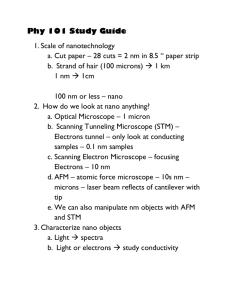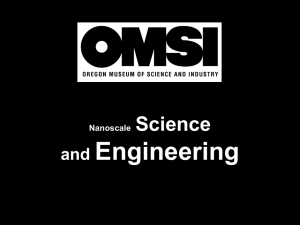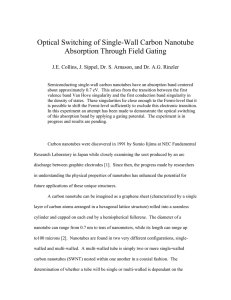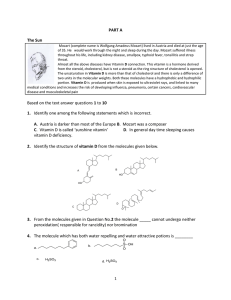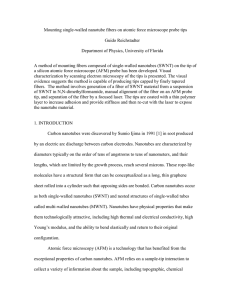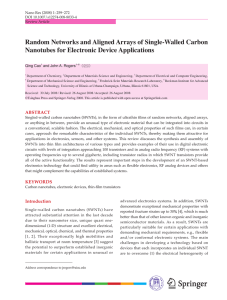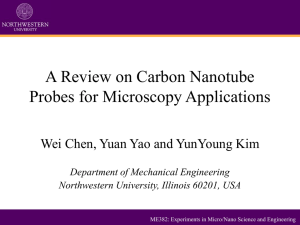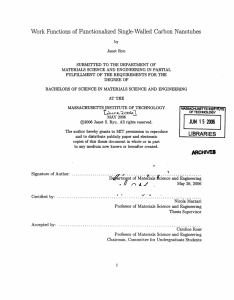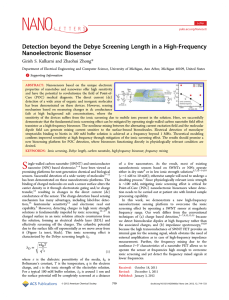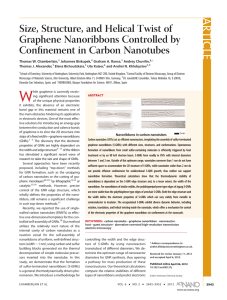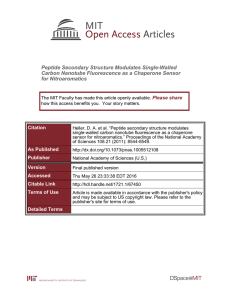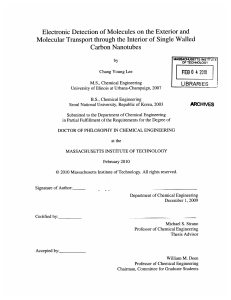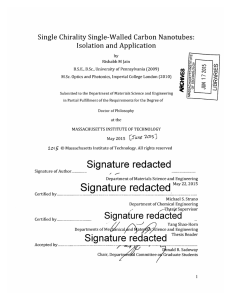Snímek 1
advertisement
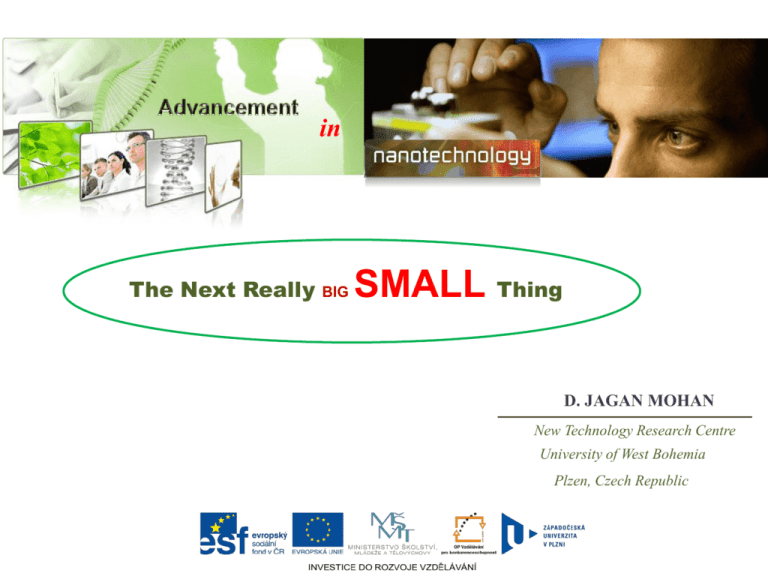
in The Next Really BIG SMALL Thing D. JAGAN MOHAN New Technology Research Centre University of West Bohemia Plzen, Czech Republic Nano..History Nano..Technology in today’s life Nano..Materials Carbon Nanotubes (CNTs) Applications Advantages/Disadvantages 1 nm = 0.000000001 m Nanotechnology is the creation and use of materials or devices at extremely small scales. Nano is Greek for “dwarf” Manipulation of matter < 100nm (1 10,000th the size of a bacterium) 80,000X smaller than a human hair 10 hydrogen atoms lined up measure about 1 nm A grain of sand is 1 million nm How small is Nanoscale……..? A nanometer is… ………one billionth of a meter DNA Sample Approx. 2 nm Human hair Approx. 1 X 10-5 nm Cutting down a cube of gold If you have a cube of pure gold and cut it, what color would the pieces be..? Now you cut those pieces. What color will each of the pieces be? If you keep doing this - cutting each block in half - will the pieces of gold always look “gold”? Well… strange things happen at the small scale If you keep cutting until the gold pieces are in the nanoscale range, they don’t look gold anymore… They look RED! Nanoparticles of gold can appear red, orange or even blue depending on size. Nano-Gold colloids exhibit different colours at different sizes and concentrations Nano…sized particles exhibit different properties than larger particles of the same substance Learn more about the nature of matter Develop new theories Discover new questions and answers in many areas, including health care, energy, and technology Figure out how to make new products and technologies that can improve people’s lives “Why cannot we write the entire 24 volumes of the Encyclopedia Britannica on the head of a pin?” Dr. Richard P. Feynman (1918-1988) 1959 R. Feynman Delivers “ Plenty of Room at the Bottom” 1974 First Molecular Electronic Device Patented 1981 Scanning Tunneling Microscopic (STM) 1986 Atomic Force Microscopy (AFM) Invented 1987 First single-electron transistor created 1991 Carbon Nanotubes Discovered Nanoscience is about the phenomena that occur in systems with nanometer dimensions. top-down Photolitography Microprinting Nanocluster 0.1 nm 1 nm 10 nm Biomolecules bottom-up Organic synthesis Self-assembly 100 nm 1 m 10 m Nanoparticle Properties Realization of miniaturized devices and systems while providing more functionality Attainment of high surface area to volume ratio Manifestation of novel phenomena and properties, including changes in… Physical Properties (e.g. melting point) Chemical Properties (e.g. reactivity) Electrical Properties (e.g. conductivity) Mechanical Properties (e.g. strength) Optical Properties (e.g. light emission) The naked eye can see to about 20 microns A human hair is about 50-100 microns thick Light microscopes let us see to about 1 micron Bounce light off of surfaces to create images Red blood cells (400x) Light microscope (magnification up to 1000x) Scanning electron microscopes (SEMs), invented in the 1930s, to see objects as small as 10 nanometers Bounce electrons off of surfaces to create images Higher resolution due to small size of electrons Blood Cells Greater resolution to see things like blood cells in greater detail Scanning probe microscopes, developed in the 1980s, give us a new way to “see” at the nanoscale We can now see really small things, like atoms, and move them too! This is about how big atoms are compared with the tip of the microscope Types of Nanomaterial Nanopowder Building blocks (less than 100 nm in diameter) for more complex nanostructures. Nanotube Carbon nanotubes are tiny strips of graphite sheet rolled into tubes a few nanometers in diameter and up to hundreds of micrometers (microns) long. CNT is a tubular form of carbon with diameter as small as 1nm. Length: few nm to microns. 100 time stronger than steel and very flexible CNT is configurationally equivalent to a two dimensional graphene sheet rolled into a tube. If added to materials like car bumpers, increases strength and flexibility Efficient electrical conductors Can act as both thermal conductors and thermal insulators CNT SWNT can be conceptualized by wrapping a one-atom-thick layer of graphite called graphene into a seamless cylinder. (diameter ~ 1nm) Multiple rolled layers of graphene sheets (5-50 nm) More resistant to chemical changes than SWNTs Multi-Walled Carbon Nanotube (MWNT) [ Sumio Ijyma (Nature,1991)] Single-Walled carbon Nanotube (SWNT) [ Ijyma, Bethune et al. (1993)] Single Crystals of SWNT [ R.R.Schlittler et al. (Science, May 2001)] Carbon Buckyballs (C60) Incredible strength due to their bond structure and “soccer ball” shape Could be useful “shells” for drug delivery Can penetrate cell walls Are nonreactive (move safely through blood stream) Precise Industrial Durable Stronger Lighter Cheaper Medical End of Illnesses (i.e. cancer, heart disease) Universal Immunity (i.e. aids, flu) Body Sculpting(i.e. change your appearance) Computers can become a billion times faster and a million times smaller Automatic Pollution Cleanup Manufacturing at almost no cost Electronics Materials Nano Transistors Nanotubes Nano Diodes Aerogel OLED Nanoparticles Applications Energy Life Sciences Batteries Targeted Drug Delivery Fuel cells Solar cells Artificial Retina Electronics Plasma Displays Quantum Computers Tissue Regeneration Power shirt The perfect match for the power tie? Meet the "Power Shirt," a piece of nanotechnology-infused clothing that will be able to generate enough electricity to power small electronic devices for soldiers in the field, hikers, or just about anyone whose physical motion can be harnessed and converted to electrical energy. Super thin battery Concept: Backed by Thin-film nanotechnology, super thin battery is capable of generating power up to 10-20 times more than regular batteries. Boasting of merely 200 microns thickness, it is thinner than a sheet of paper. It consists of lithium phosphorus oxynitride (LiPON) that imparts it with its flexible quality and increased storage capacity. In addition, it gets charged up to 80% in just 15 minutes. Energy Solar cells Fuel cells Batteries Bio fuels Information Technology Smaller, faster, more energy efficient and powerful computing and other IT-based Consumer Foods systems Foods and beverages Advanced packaging materials, sensors, Medicine Appliances and textiles Stain proof, water proof / wrinkle free textiles Cancer treatment Household and cosmetics Bone treatment Self-cleaning and scratch free products, paints Drug delivery Appetite control Drug development Medical tools Diagnostic tests Imaging Disadvantages Loss of jobs (in manufacturing, farming, etc) Carbon Nanotubes could cause infection of lungs Oil & Diamonds could become worthless Atomic weapons could be more accessible and destructive
